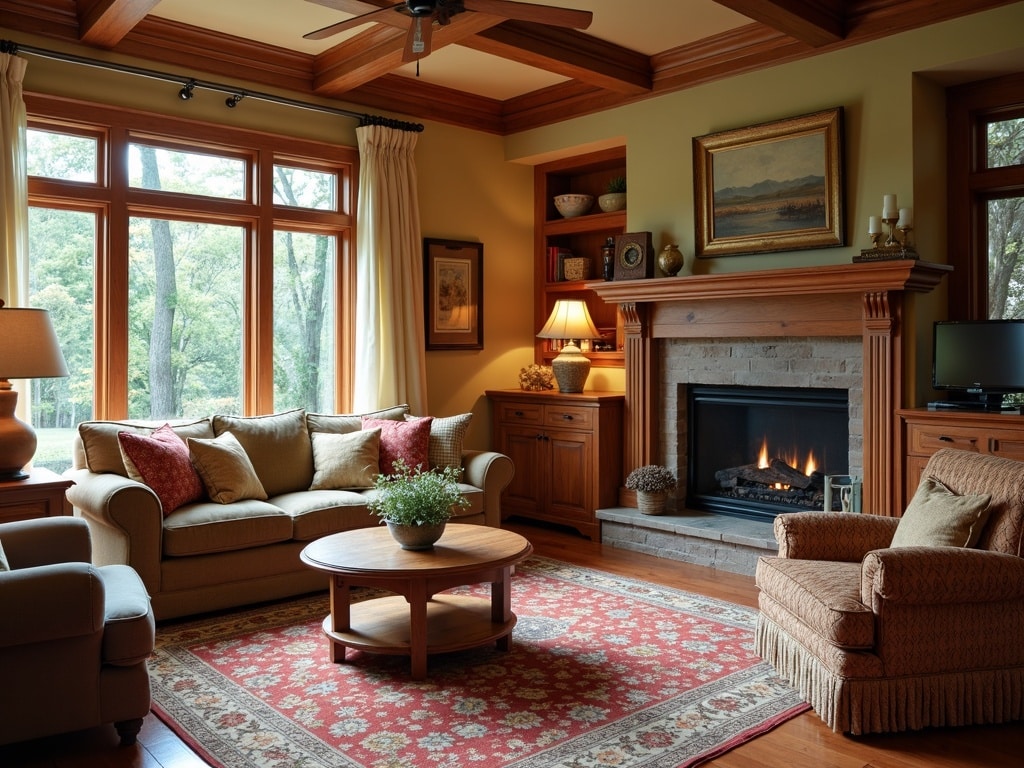Craftsman Furniture: The Enduring Style That Defines Your Home
What is Craftsman Furniture? Origins and Defining Characteristics
Imagine a home filled with solid, honest furniture. Pieces that feel like they were built to last, radiating warmth and unpretentious beauty. That’s the essence of Craftsman furniture. Born from the late 19th and early 20th-century Arts and Crafts movement, it’s a style that champions handcraftsmanship, natural materials, and simple, functional design. Think sturdy oak, exposed joinery, and a distinct lack of frills. Craftsman furniture isn't just about filling a space; it's about creating a haven rooted in authenticity and enduring quality.
The History and Evolution of the Craftsman Style
The Craftsman style emerged as a reaction against the mass-produced, overly ornamented furniture of the Victorian era. Disillusioned by industrialization, proponents of the Arts and Crafts movement, like William Morris, sought to revive traditional crafts and bring integrity back to design. In America, Gustav Stickley became a leading figure, popularizing Craftsman furniture through his magazine, The Craftsman, and his signature line of furniture. The style quickly spread across the country, influencing architecture and interior design. While the movement itself faded, the core values of quality, simplicity, and functionality embedded in Craftsman furniture continue to resonate today.
Key Features that Define Authentic Craftsman Furniture
What exactly makes a piece of furniture Craftsman? Several key characteristics define the style:
- Solid Wood Construction: Typically made from oak, but also cherry, maple, and other hardwoods.
- Simple, Straight Lines: Emphasis on functionality over ornate decoration.
- Exposed Joinery: Dovetails, mortise and tenon joints, and other construction details are often visible, showcasing the craftsmanship.
- Handcrafted Details: Details like hand-hammered copper hardware or leaded glass add a touch of artistry.
- Warm, Natural Finishes: Stained to enhance the natural wood grain, rather than painted over.
- Unadorned Surfaces: Minimal carving or embellishment, allowing the natural beauty of the wood to shine through.
Identifying Genuine Craftsman Furniture: Materials, Joinery, and Details
Distinguishing genuine Craftsman furniture from imitations requires a keen eye. Examine the materials: real Craftsman pieces use solid wood, not veneers or particleboard. Look closely at the joinery; exposed dovetails and mortise-and-tenon joints are hallmarks of quality craftsmanship. Hardware should be made of solid materials like copper or iron, often with a hand-hammered texture. Details matter. Genuine pieces often feature subtle, handcrafted elements that mass-produced furniture lacks. Maker's marks or stamps can also help authenticate a piece, particularly for those seeking antique Craftsman furniture.
Notable Craftsman Furniture Makers and Their Contributions
Several names stand out in the history of Craftsman furniture. Gustav Stickley is perhaps the most well-known, his furniture embodying the principles of the Arts and Crafts movement. His company, Stickley Furniture, produced iconic pieces that are highly sought after today. Other notable makers include L. & J.G. Stickley (Gustav's brothers), Charles Limbert, and the Roycroft Shops. Each maker brought their unique style to the Craftsman aesthetic, contributing to the rich diversity of the movement.
The Enduring Appeal of Craftsman Furniture: Why it Remains Popular Today
In a world dominated by mass-produced items and fleeting trends, Craftsman furniture holds a timeless appeal. Its solid construction and simple design evoke a sense of stability and permanence. The emphasis on natural materials connects us to the beauty of the natural world. And the handcrafted details add a touch of artistry that is often lacking in modern furniture. Beyond aesthetics, Craftsman furniture represents a commitment to quality and enduring value – a welcome contrast to the disposable culture of today.
Decorating Your Home with Craftsman Furniture: Tips and Ideas
Integrating Craftsman furniture into your home décor can create a warm, inviting, and authentic atmosphere. Start by choosing a few key pieces that reflect your personal style. A sturdy oak dining table, a comfortable Morris chair, or a handcrafted bookcase can serve as focal points in a room. Use warm, earthy colors such as browns, greens, and golds to complement the wood tones. Accessorize with natural materials like wool rugs, linen curtains, and pottery to create a cohesive and inviting space. Avoid clutter and embrace simplicity – less is often more when decorating with Craftsman furniture.
Incorporating Craftsman Furniture into Different Room Styles
While often associated with a traditional aesthetic, Craftsman furniture can be surprisingly versatile and work well within varied room styles. In a modern setting, a few carefully chosen Craftsman pieces can add warmth and character. Juxtapose a sleek, minimalist sofa with a Craftsman-style coffee table or side table for an intriguing contrast. In a rustic or farmhouse-style home, Craftsman furniture blends seamlessly with the existing décor, enhancing the sense of authenticity and charm. Embrace the interplay of textures and materials to create a space that is both stylish and inviting.

Caring for and Maintaining Craftsman Furniture to Preserve Its Beauty and Value
Craftsman furniture is built to last, but proper care is essential to preserve its beauty and value for generations to come. Dust regularly with a soft cloth to prevent buildup. Avoid placing furniture in direct sunlight or near heat sources, as this can cause the wood to dry out and crack. Polish occasionally with a high-quality furniture polish specifically designed for wood. For antique pieces, consult with a professional conservator for any significant repairs or restoration work. With proper care, your Craftsman furniture will continue to be a cherished part of your home for years to come.
Where to Buy Craftsman Furniture: Modern vs. Antique Options
Whether you prefer antique or modern, there are many options available for purchasing Craftsman furniture. Antique pieces can be found at antique stores, estate sales, and online auctions. Look for reputable dealers who specialize in Arts and Crafts furniture. Modern Craftsman furniture is available from a variety of manufacturers, including Stickley and smaller, independent craftspeople. Consider visiting craft fairs and artisan markets to discover unique, handcrafted pieces. Research your options carefully and choose pieces that meet your budget and style preferences.
The Investment Value of Craftsman Furniture: Is it a Good Investment?
Craftsman furniture can be a wise investment, both aesthetically and financially. Antique Craftsman pieces, particularly those made by renowned makers like Gustav Stickley, have consistently increased in value over time. Modern Craftsman furniture, crafted with high-quality materials and traditional techniques, also holds its value well. Beyond financial gain, Craftsman furniture provides a sense of enduring beauty and craftsmanship that enriches your home and your life. When purchasing Craftsman furniture, consider it as an investment in quality, timeless design, and lasting value.
Craftsman Furniture vs. Other Furniture Styles: A Comparative Analysis
Understanding the differences between Craftsman furniture and other styles can help you appreciate its unique qualities. Compared to Victorian furniture, Craftsman furniture is simpler, more functional, and less ornate. Unlike Mid-Century Modern furniture, Craftsman emphasizes natural materials and handcrafted details over sleek, minimalist design. In contrast to contemporary furniture, Craftsman offers a sense of warmth, tradition, and enduring value. Each style has its merits, but Craftsman furniture stands out for its commitment to quality, craftsmanship, and timeless appeal.
Modern Interpretations of the Craftsman Style: Blending Traditional and Contemporary Elements
The Craftsman style continues to evolve, with modern interpretations that blend traditional elements with contemporary sensibilities. These pieces often incorporate clean lines, updated materials, and fresh color palettes. Think of a Craftsman-inspired sofa upholstered in a modern fabric or a dining table with a sleek, minimalist base. By incorporating these modern twists, you can enjoy the warmth and quality of Craftsman design in a way that complements your contemporary lifestyle and preferences.
DIY Craftsman Furniture Projects: Building Your Own Pieces
For those who enjoy hands-on projects, building your own Craftsman furniture can be a rewarding experience. Numerous online resources and books provide plans and instructions for creating everything from simple bookshelves to more complex chairs and tables. Building your own furniture not only allows you to customize the design to your exact specifications, but it also provides a deeper appreciation for the craftsmanship and skill involved in creating these timeless pieces. Plus, you'll have a unique, handcrafted piece that you can cherish for years to come.
The Future of Craftsman Furniture: Trends and Innovations
While rooted in tradition, the Craftsman style is not static. Today, we see innovations in materials, techniques, and design that are shaping the future of Craftsman furniture. Sustainable materials, such as reclaimed wood and bamboo, are becoming increasingly prevalent. Digital design and manufacturing technologies are allowing craftspeople to create intricate details with greater precision. And collaborations between designers and artisans are resulting in fresh, contemporary interpretations of the classic Craftsman aesthetic. As the world continues to value quality, craftsmanship, and enduring design, the Craftsman style is poised to remain relevant and inspiring for generations to come. It's a style that doesn’t just furnish a home; it defines it.

